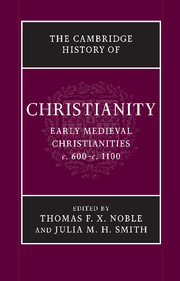Book contents
- Frontmatter
- Introduction: Christendom, c. 600
- Part I Foundations: Peoples, Places, and Traditions
- 1 Late Roman Christianities
- 2 The emergence of Byzantine Orthodoxy, 600–1095
- 3 Beyond empire I: Eastern Christianities from the Persian to the Turkish conquest, 604–1071
- 4 Beyond empire II: Christianities of the Celtic peoples
- 5 Germanic Christianities
- 6 Slav Christianities, 800–1100
- Part II Christianity in Confrontation
- Part III Christianity in the Social and Political Order
- Part IV Christianity as Lived Experience
- Part V Christianity: Books and Ideas
- Conclusion: Christendom, c. 1100
- Bibliographies
- Index
- References
5 - Germanic Christianities
from Part I - Foundations: Peoples, Places, and Traditions
Published online by Cambridge University Press: 28 March 2010
- Frontmatter
- Introduction: Christendom, c. 600
- Part I Foundations: Peoples, Places, and Traditions
- 1 Late Roman Christianities
- 2 The emergence of Byzantine Orthodoxy, 600–1095
- 3 Beyond empire I: Eastern Christianities from the Persian to the Turkish conquest, 604–1071
- 4 Beyond empire II: Christianities of the Celtic peoples
- 5 Germanic Christianities
- 6 Slav Christianities, 800–1100
- Part II Christianity in Confrontation
- Part III Christianity in the Social and Political Order
- Part IV Christianity as Lived Experience
- Part V Christianity: Books and Ideas
- Conclusion: Christendom, c. 1100
- Bibliographies
- Index
- References
Summary
A rich combination of ingredients – biblical, Roman, and Irish – contributed to the character of Christian life in the Germanic world of the early Middle Ages, blending with the legacy of the pre-Christian Germanic past. To apply a linguistic category to religion and religious practice and talk of a typical Christianity practiced by speakers of Germanic languages would be misleading, especially across such a vast area and such an eventful half-millennium. “Germanic Christianities,” interpreted geographically not ethnically, will be taken here to relate to the churches and Christian communities that developed in the Germanic-speaking world, first in the context of the barbarian successor-states within the old Roman Empire, and then, thanks to political and economic forces, as well as missionary activity, in new lands well beyond the old frontier.
There was nevertheless an ethnic dimension to the earliest Germanic conversions. The first converts, the Goths, subscribed to the teachings that came to be condemned as the Arian heresy, and, after their conversion in the fourth century, Arianism became identified with Germanic Christianity. While it lingered in Italy among the Lombards through the seventh century, in Spain by 589 CE the last major Arian ruler, the Visigoth Reccared, had accepted Catholicism. It has been suggested that upon entering the Roman world the Germanic peoples chose, and subsequently remained committed to, this increasingly unorthodox form of Christianity as a means of asserting their social identity and cultural independence. The circumstance that the Roman emperors who presided over the initial Gothic conversion were Arians had led the first converts in a direction that the mainstream church soon abandoned.
- Type
- Chapter
- Information
- The Cambridge History of Christianity , pp. 107 - 129Publisher: Cambridge University PressPrint publication year: 2008
References
- 3
- Cited by

